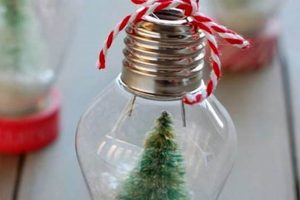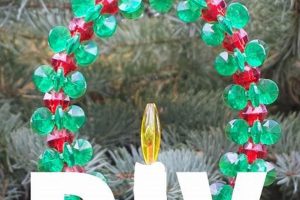Creating personalized decorative elements for aquatic environments through do-it-yourself projects is an accessible avenue for hobbyists. These projects involve crafting customized features and accessories to enhance the aesthetic appeal of an aquarium, utilizing readily available materials and simple techniques. Examples include constructing miniature castles from inert plastics, fashioning artificial plants from aquarium-safe fabrics, or designing unique rock formations from slate or other non-toxic stone.
The practice of customizing aquarium decor offers several advantages. It allows for complete control over the visual design of the tank, enabling a more personalized and aesthetically pleasing display. Furthermore, undertaking such projects can be a more economical option compared to purchasing commercially produced items. Historically, hobbyists have engaged in creating their own aquarium features as a means of both cost savings and creative expression, leading to diverse and innovative approaches to aquascaping.
The following discussion will address key considerations for crafting safe and appealing decorations. This includes material selection to avoid water contamination, structural design for fish safety and habitat enrichment, and techniques for creating visually interesting and functional additions to an aquatic environment. These elements are crucial for success in enhancing the aquarium experience.
Essential Considerations for Aquarium Decoration Construction
The creation of bespoke aquarium features requires careful attention to detail to ensure the safety and well-being of aquatic inhabitants, along with the longevity of the aquarium environment.
Tip 1: Material Selection is Paramount: Employ only non-toxic, aquarium-safe materials. Avoid using paints, glues, or plastics that may leach harmful chemicals into the water. Opt for materials specifically labelled as safe for aquatic use.
Tip 2: Thorough Cleaning and Preparation: Prior to introducing any newly constructed item, meticulously clean and disinfect it. Boiling rocks or other natural materials can help eliminate potential contaminants.
Tip 3: Structural Integrity and Stability: Ensure that any constructed item is structurally sound and stable within the aquarium. Avoid designs that could collapse or topple, potentially injuring fish or damaging the tank.
Tip 4: Avoid Sharp Edges and Abrasive Surfaces: Inspect all surfaces for sharp edges or abrasive areas that could harm delicate fins or scales. Smooth any rough spots before introducing the item to the aquarium.
Tip 5: Consider Water Flow and Circulation: Design elements should not impede water flow or create dead zones within the aquarium. Proper circulation is essential for maintaining water quality and oxygen levels.
Tip 6: Mimic Natural Habitats: Strive to create elements that resemble the natural environment of the fish species being housed. This can include providing caves, crevices, and shaded areas for refuge.
Tip 7: Gradual Introduction and Monitoring: Introduce new features to the aquarium gradually. Closely monitor the fish for any signs of stress or unusual behavior following the introduction.
Tip 8: Regular Inspection and Maintenance: Regularly inspect newly constructed items for signs of deterioration or algae growth. Promptly address any issues to maintain water quality and the integrity of the design.
Adhering to these guidelines will facilitate the creation of a safe, aesthetically pleasing, and enriching environment for aquatic life, while also ensuring the long-term stability and health of the aquarium ecosystem.
The subsequent section will delve into the creative aspects of ornament construction, providing inspiration and practical guidance for designing unique and engaging aquarium displays.
1. Material Safety
Material safety is a paramount concern in the construction of decorations for aquatic environments. The selection of inappropriate materials can have detrimental effects on water quality and the health of the fish and other organisms inhabiting the aquarium. Understanding the potential risks associated with different materials is essential for responsible creation of custom aquarium features.
- Inertness and Leaching
Materials used within an aquarium must be chemically inert to prevent leaching of harmful substances into the water column. Certain plastics, paints, and metals can release toxins that alter pH, introduce heavy metals, or otherwise degrade water quality. For example, using unsealed concrete or certain types of painted ceramics can lead to significant alterations in water chemistry, potentially causing distress or mortality to aquatic life.
- Biological Compatibility
The material should be biologically compatible with the aquarium environment, meaning it should not promote the growth of unwanted organisms or decompose rapidly. Untreated wood, for instance, can decay and contribute to elevated levels of organic waste, leading to bacterial blooms and oxygen depletion. Conversely, certain materials can harbor harmful bacteria or parasites that can infect the aquarium inhabitants.
- Physical Stability
The chosen material must maintain its physical integrity over time when submerged in water. Materials that crumble, dissolve, or otherwise degrade can release particles into the water, clouding the aquarium and potentially clogging filtration systems. Furthermore, small particles ingested by fish can cause digestive problems or internal injuries.
- Absence of Sharp Edges and Protrusions
The surface of the material should be smooth and free of sharp edges or protrusions that could injure the fish. Fish often rub against decorations or hide within them, and abrasive surfaces can damage their scales or fins, making them susceptible to infections. For example, using rough, unpolished rocks or decorations with sharp points can lead to physical trauma in fish.
The careful selection of materials is therefore critical for ensuring the safety and longevity of custom aquarium decorations. Prioritizing inert, biologically compatible, physically stable, and smooth materials minimizes the risks of water contamination, biological imbalances, and physical harm to aquatic life, contributing to a healthy and thriving aquarium ecosystem. Examples of appropriate materials include aquarium-safe silicone, certain types of plastic explicitly designed for aquatic use, and thoroughly cleaned and sterilized natural rocks or driftwood obtained from reputable sources.
2. Design Functionality
The functionality of a custom-built aquarium ornament is directly linked to the well-being of the aquatic ecosystem it inhabits. Design choices inherently influence water flow, habitat creation, and the overall health of the aquarium inhabitants. Poorly designed ornaments can obstruct circulation, creating dead zones that accumulate waste and deplete oxygen. Conversely, well-designed elements can enhance water movement, promote gas exchange, and provide varied habitats for different species. For example, constructing a cave-like structure provides shelter for shy fish, reducing stress and promoting natural behaviors. The functionality serves as the foundation upon which aesthetic considerations are built, since visual appeal is secondary to creating a safe and enriching environment.
Practical application of functional design principles extends to material selection and construction techniques. Permeable structures, such as those created with carefully stacked rocks or porous materials, can act as biological filtration sites, fostering beneficial bacteria colonies that aid in the nitrogen cycle. The size and placement of openings within ornaments must accommodate the fish species housed, preventing entrapment while allowing for exploration and retreat. The inclusion of features that mimic natural habitats, such as overhangs or simulated plant roots, can further enhance the functionality of an ornament by providing spawning sites or foraging areas. Additionally, designs should facilitate cleaning and maintenance; complex, intricate structures may be visually appealing but prove difficult to clean, leading to detritus accumulation and potential water quality issues. Considering these aspects ensures that the ornaments are not merely decorative but also contribute positively to the aquarium’s ecological balance.
In summary, design functionality is an indispensable component of crafting aquarium ornaments. It necessitates a comprehensive understanding of aquatic ecosystems and the specific needs of the species being housed. By prioritizing function, the hobbyist ensures that the created feature actively contributes to a healthy and thriving environment. Challenges arise in balancing aesthetic preferences with functional requirements, necessitating careful planning and execution. Ultimately, the successful integration of form and function is a testament to the craftsperson’s understanding and commitment to the welfare of the aquatic inhabitants.
3. Structural Integrity
Structural integrity is a critical consideration in do-it-yourself aquarium decoration. The durability and stability of these handcrafted elements directly impact the safety and well-being of aquatic inhabitants, as well as the long-term maintenance and aesthetic appeal of the aquarium.
- Material Load Capacity
The chosen materials must withstand the constant pressure of water and any additional weight they support. For instance, stacked rock formations must be constructed with materials strong enough to prevent collapse. Failure to account for load capacity can result in shifting structures, potential injury to fish, and the release of debris into the water.
- Resistance to Degradation
Aquatic environments promote material degradation. Porous materials can become saturated, increasing their weight and susceptibility to crumbling. Materials prone to dissolving or leaching chemicals compromise water quality. Selecting materials resistant to these effects, such as certain inert plastics or sealed ceramics, is essential for sustained structural integrity.
- Joint Stability
The points where different materials connect are often the weakest links in a structure. Adhesives used to bond materials must be waterproof, non-toxic, and capable of withstanding constant submersion. Mechanical fasteners, such as pegs or dowels, require precise fitting to maintain structural integrity. Failure at these joints can lead to separation of components and potential hazards within the aquarium.
- Design for Stability
Ornament design profoundly affects structural stability. Top-heavy structures are more prone to tipping, while designs with narrow bases are less stable than those with broad foundations. Distributing weight evenly and incorporating interlocking features enhances overall stability. Designs that consider water flow and minimize resistance to currents reduce the likelihood of displacement.
These facets of structural integrity underscore the necessity of careful planning and execution in crafting aquarium features. Prioritizing material selection, robust construction techniques, and stable designs mitigates the risks associated with structurally unsound ornaments. The longevity, safety, and aesthetic appeal of the crafted environment rely on this foundation.
4. Aesthetic Harmony
The creation of aesthetically pleasing aquatic environments necessitates a deliberate integration of visual elements, influencing the overall perception of the aquarium as a miniature ecosystem. In the context of self-made aquarium ornaments, achieving aesthetic harmony requires a careful consideration of color palettes, scale, and texture. The selection of materials and the design of features must align with the intended visual theme. For instance, an aquarium designed to replicate a South American riverbed will benefit from ornaments that utilize earthy tones, smooth river rocks, and driftwood-like structures. Conversely, a vibrant reef tank may incorporate brightly colored corals and intricate rock formations, demonstrating a fundamentally different aesthetic objective. The consequence of neglecting this holistic approach can be a visually disjointed environment that fails to convincingly simulate a natural habitat or offer a coherent visual experience. Real-world examples abound where poorly chosen ornaments clash with the overall aquarium design, resulting in a visually jarring and unnatural display.
Practical application of aesthetic principles involves a critical assessment of the existing aquarium setup. The size of the tank, the color of the substrate, and the type of lighting all influence the perceived aesthetics. A large, imposing ornament can overwhelm a small aquarium, disrupting the sense of scale. Similarly, ornaments with sharp angles and unnatural colors can contrast unfavorably with the organic shapes and hues of live plants and fish. Achieving harmony therefore requires a balancing act, where the crafted elements complement, rather than compete with, the existing features. Consideration must also be given to the long-term development of the aquarium. Ornaments that initially appear aesthetically pleasing may become overgrown with algae or coated with detritus over time, diminishing their visual appeal. Consequently, the design should anticipate the need for cleaning and maintenance, ensuring that the initial aesthetic integrity is preserved. This necessitates a thoughtful selection of materials that are resistant to algae growth and easy to clean, as well as a design that allows for access and manipulation within the confined space of the aquarium.
In conclusion, aesthetic harmony is an indispensable element in the realm of fish tank ornaments. Its achievement is not merely a matter of personal preference, but a critical factor in creating a visually engaging and ecologically believable aquatic environment. Challenges in this endeavor frequently stem from a lack of planning or an insufficient understanding of design principles. Successfully integrating homemade ornaments into an aquarium requires a balance between artistic expression and a meticulous attention to detail, linking directly to the broader themes of responsible aquascaping and animal welfare.
5. Aquatic Welfare
Aquatic welfare, in the context of “fish tank ornaments diy,” is not merely a secondary consideration but a primary responsibility. The design, materials, and construction of homemade aquarium decorations directly influence the health, safety, and behavioral expression of aquatic inhabitants. Neglecting welfare considerations can lead to physiological stress, injury, and ultimately, reduced lifespan for the animals housed within the artificially constructed ecosystem.
- Material Toxicity and Water Quality
The selection of materials is paramount to maintaining water quality. Improper materials can leach harmful chemicals, altering pH, increasing toxicity, or promoting the growth of undesirable microorganisms. For example, using unsealed concrete or certain plastics can introduce heavy metals or alter water chemistry, leading to stress and potentially mortality in sensitive fish species. Safe materials include aquarium-grade silicone, specific types of inert plastic, and thoroughly cleaned natural rocks. The use of toxic materials directly compromises the integrity of the aquatic environment and the well-being of its inhabitants.
- Physical Hazards and Injury Prevention
The design and construction must prioritize safety to prevent physical injuries. Sharp edges, small crevices, or unstable structures can pose significant risks. Fish may scrape themselves against rough surfaces, leading to fin damage and infections. Small openings can trap smaller fish, leading to stress or even death. Unstable structures can collapse, causing physical trauma. Rounded edges, secure construction, and the avoidance of small, inaccessible spaces are essential for minimizing physical hazards.
- Behavioral Enrichment and Habitat Provision
Ornaments can serve as vital sources of behavioral enrichment. Providing hiding places, caves, and territories allows fish to exhibit natural behaviors, reducing stress and aggression. For example, territorial fish require designated areas to establish dominance, while shy species need secluded retreats. Designs that mimic natural habitats, such as providing overhangs or simulated plant roots, can further enhance behavioral expression. The absence of such features can lead to chronic stress, suppressed immune function, and increased susceptibility to disease.
- Water Flow and Oxygenation Disruption
Poorly designed ornaments can impede water flow and disrupt oxygenation, creating stagnant areas that accumulate waste and deplete oxygen levels. These dead zones can harbor anaerobic bacteria, producing toxic byproducts that further degrade water quality. Ornaments should be designed to promote circulation, allowing for efficient gas exchange and waste removal. Open structures, porous materials, and strategic placement can enhance water flow and contribute to a healthier aquatic environment.
The four areas intersect and significantly shape an aquarium’s ecosystem. When creating do-it-yourself aquarium ornaments, a comprehensive understanding of these factors is essential. The ethical imperative to ensure aquatic welfare must guide every decision, from material selection to structural design, guaranteeing a safe, healthy, and enriching environment for all aquarium inhabitants.
6. Maintenance Ease
The construction of aquarium ornaments directly influences the long-term effort required to maintain a healthy and aesthetically pleasing aquatic environment. Ornaments with complex designs or inappropriate materials can significantly increase the burden of regular maintenance. Consequently, design simplicity and material selection are integral to ensuring ease of upkeep. A direct correlation exists between the intricacy of an ornament’s structure and the difficulty of removing algae and detritus. Complex structures provide more surface area for algae colonization and create areas where debris accumulates, hindering effective cleaning. Similarly, materials that are porous or prone to degradation can trap debris and become difficult to clean without causing damage. An example includes ornate resin decorations with tiny crevices; while visually appealing, these are notorious for harboring algae and detritus, requiring meticulous scrubbing or eventual removal from the aquarium. In contrast, smooth, non-porous materials with simple designs facilitate easy cleaning, reducing the frequency and intensity of maintenance tasks.
Practical application of maintenance-focused design involves considering the long-term implications of each element. Ornament designs should minimize nooks and crannies where debris can accumulate. Materials should be chosen for their resistance to algae growth and their ability to withstand regular cleaning. For instance, using smooth river rocks instead of porous lava rocks reduces the surface area available for algae to adhere to. Furthermore, modular designs allow for easy removal and cleaning of individual components. The positioning of ornaments within the aquarium should also be considered. Placing ornaments in areas with strong water flow helps to prevent the accumulation of detritus. The accessibility of ornaments for cleaning is also important; ornaments that are difficult to reach or manipulate within the aquarium are less likely to be cleaned regularly. This leads to a decline in aesthetic appeal and potentially compromises water quality. Considering these practical aspects will significantly reduce the workload associated with maintaining the aquarium.
In conclusion, the ease of maintenance is a central factor in the successful creation of custom aquarium features. By prioritizing simple designs, selecting appropriate materials, and considering the long-term implications of ornament placement and construction, aquarium hobbyists can significantly reduce the burden of regular maintenance. This focus ensures both a visually appealing and a healthy aquatic environment, minimizing the effort required to maintain its optimal condition. The challenges lie in balancing aesthetic desires with practical considerations, requiring a thoughtful and informed approach to ornament design and construction. Ultimately, the long-term viability of a custom aquarium environment hinges on the ease with which it can be maintained.
Frequently Asked Questions
This section addresses common inquiries regarding the creation and implementation of self-made aquarium decorations. The information provided aims to clarify concerns and promote responsible practices.
Question 1: What materials are definitively unsafe for crafting aquarium ornaments?
Materials to avoid include any metals that are not explicitly designated as aquarium-safe (e.g., untreated steel, copper), paints or adhesives that are not specifically labeled as non-toxic and waterproof for aquarium use, and porous materials that can harbor bacteria or leach contaminants (e.g., certain types of untreated wood, unsealed concrete).
Question 2: How should newly constructed decorations be prepared before introduction to the aquarium?
Thorough cleaning is essential. This involves scrubbing with a new, dedicated brush (never used with soap or other household cleaners) and rinsing extensively with dechlorinated water. Boiling natural materials, such as rocks, can help remove potential pathogens. New decorations should be soaked in a separate container of dechlorinated water for several days, with regular water changes, to further leach out any remaining contaminants before being introduced into the aquarium.
Question 3: How can the stability of constructed rock formations be ensured within the aquarium?
Employ a stable base and avoid top-heavy designs. Aquarium-safe silicone adhesive can be used to bond rocks together, creating a more solid structure. Consider using interlocking designs or carefully stacking rocks to distribute weight evenly and prevent collapses. Regular inspection of the structure is advised to identify and address any signs of instability.
Question 4: What design features promote aquatic welfare?
Designs that provide hiding places, caves, and territories are essential for reducing stress and promoting natural behaviors. Avoid sharp edges or small crevices that could trap fish. The placement of ornaments should not impede water flow or create stagnant areas. The dimensions of entrances and internal spaces should be appropriately sized for the fish species being housed.
Question 5: How can algae growth on custom decorations be managed?
Select materials that are less prone to algae growth, such as smooth surfaces. Position ornaments to allow for good water flow and light penetration. Regular cleaning with an algae scraper or soft brush is necessary. Consider introducing algae-eating inhabitants, such as snails or certain types of fish, to help control algae growth.
Question 6: What are the indications that an aquarium ornament is negatively impacting the aquatic environment?
Changes in water parameters (pH, ammonia, nitrite, nitrate levels), unexplained illness or death of fish, excessive algae growth, cloudiness of the water, or visible degradation of the ornament itself are potential signs of a problem. If any of these signs are observed, the ornament should be removed and the water tested to identify the cause of the issue.
In summary, crafting safe and appealing aquarium decorations requires careful consideration of materials, design, and maintenance. Prioritizing aquatic welfare and adhering to established guidelines helps ensure a healthy and thriving aquarium environment.
The subsequent section will present a compilation of creative project ideas, providing inspiration for crafting diverse and engaging aquarium displays.
Conclusion
This exploration of fish tank ornaments diy has underscored the critical interplay between aesthetic expression, material safety, and the well-being of aquatic life. Considerations of design functionality, structural integrity, and maintenance ease have been examined, highlighting the multifaceted nature of creating custom aquarium features. The preceding discussion emphasizes the responsibility inherent in modifying a delicate ecosystem, promoting practices that prioritize the health and safety of its inhabitants.
The informed application of the principles outlined herein will contribute to the creation of aquariums that are both visually captivating and ecologically sound. The continuous pursuit of knowledge and the meticulous application of established guidelines remain paramount in the realm of aquatic husbandry, ensuring the long-term vitality of these microcosmic environments.







